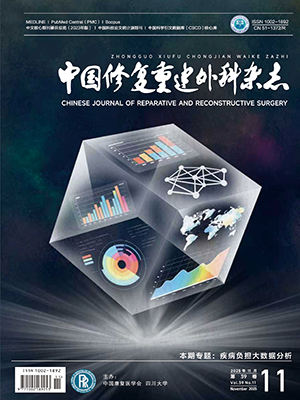| 1. |
鲁谊, 朱以明, 姜春岩. 肌腱联合固定术治疗巨大肩袖损伤合并肱二头肌长头腱病变的临床观察. 中华医学杂志, 2011, 91(23):1591-1594.
|
| 2. |
Rockwood CA Jr, Williams GR Jr, Burkhead WZ Jr. Débridement of degenerative, irreparable lesions of the rotator cuff. J Bone Joint Surg (Am), 1995, 77(6):857-866.
|
| 3. |
Goutallier D, Postel JM, Bernageau J, et al. Fatty muscle degeneration in cuff ruptures. Pre- and postoperative evaluation by CT scan. Clin Orthop Relat Res, 1994, (304):78-83.
|
| 4. |
Constant CR, Murley AH. A clinical method of functional assessment of the shoulder. Clin Orthop Relat Res, 1987, (214):160-164.
|
| 5. |
Ellman H, Hanker G, Bayer M. Repair of the rotator cuff. End-result study of factors influencing reconstruction. J Bone Joint Surg (Am), 1986, 68(8):1136-1144.
|
| 6. |
Roy JS, Macdermid JC, Woodhouse LJ. Measuring shoulder function:a systematic review of four questionnaires. Arthritis Rheum, 2009, 61(5):623-632.
|
| 7. |
Neviaser TJ, Neviaser RJ, Neviaser JS, et al. The four-in-one arthroplasty for the painful arc syndrome. Clin Orthop Relat Res, 1982, (163):107-112.
|
| 8. |
Wu PT, Jou IM, Yang CC, et al. The severity of the long head biceps tendinopathy in patients with chronic rotator cuff tears:macroscopic versus microscopic results. J Shoulder Elbow Surg, 2014, 23(8):1099-1106.
|
| 9. |
Refior HJ, Sowa D. Long tendon of the biceps brachii:sites of predilection for degenerative lesions. J Shoulder Elbow Surg, 1995, 4(6):436-440.
|
| 10. |
Ide J, Tokiyoshi A, Hirose J, et al. Arthroscopic repair of traumatic combined rotator cuff tears involving the subscapularis tendon. J Bone Joint Surg (Am), 2007, 89(11):2378-2388.
|
| 11. |
Namdari S, Henn RF 3rd, Green A. Traumatic anterosuperior rotator cuff tears:the outcome of open surgical repair. J Bone Joint Surg (Am), 2008, 90(9):1906-1913.
|
| 12. |
Miller C, Savoie FH. Glenohumeral abnormalities associated with full-thickness tears of the rotator cuff. Orthop Rev, 1994, 23(2):159-162.
|
| 13. |
Chen CH, Chen CH, Chang CH, et al. Classification and analysis of pathology of the long head of the biceps tendon in complete rotator cuff tears. Chang Gung Med J, 2012, 35(3):263-270.
|
| 14. |
Duff SJ, Campbell PT. Patient acceptance of long head of biceps brachii tenotomy. J Shoulder Elbow Surg, 2012, 21(1):61-65.
|
| 15. |
Karataglis D, Papadopoulos P, Boutsiadis A, et al. Ultrasound evaluation of the distal migration of the long head of biceps tendon following tenotomy in patients undergoing arthroscopic repair of tears of the rotator cuff. J Bone Joint Surg (Br), 2012, 94(11):1534-1539.
|
| 16. |
Hsu AR, Ghodadra NS, Provencher MT, et al. Biceps tenotomy versus tenodesis:a review of clinical outcomes and biomechanical results. J Shoulder Elbow Surg, 2011, 20(2):326-332.
|
| 17. |
Kelly AM, Drakos MC, Fealy S, et al. Arthroscopic release of the long head of the biceps tendon:functional outcome and clinical results. Am J Sports Med, 2005, 33(2):208-213.
|
| 18. |
Koh KH, Ahn JH, Kim SM, et al. Treatment of biceps tendon lesions in the setting of rotator cuff tears:prospective cohort study of tenotomy versus tenodesis. Am J Sports Med, 2010, 38(8):1584-1590.
|
| 19. |
Mazzocca AD, Bicos J, Santangelo S, et al. The biomechanical evaluation of four fixation techniques for proximal biceps tenodesis. Arthroscopy, 2005, 21(11):1296-1306.
|
| 20. |
Friedman DJ, Dunn JC, Higgins LD, et al. Proximal biceps tendon:injuries and management. Sports Med Arthrosc, 2008, 16(3):162-169.
|
| 21. |
Habermeyer P, Magosch P, Pritsch MT, et al. Anterosuperior impingement of the shoulder as a result of pulley lesions:a prospective arthroscopic study. J Shoulder Elbow Surg, 2004, 13(1):5-12.
|
| 22. |
Gerber C, Sebesta A. Impingement of the deep surface of the subscapularis tendon and reflection pulley on the anterosuperior glenoid rim:a preliminary report. J Shoulder Elbow Surg, 2000, 9(6):483-490.
|
| 23. |
Neer CS 2nd. Anterior acromioplasty for the chronic impingement syndrome in the shoulder:a preliminary report. J Bone Joint Surg (Am), 1972, 54(1):41-50.
|




